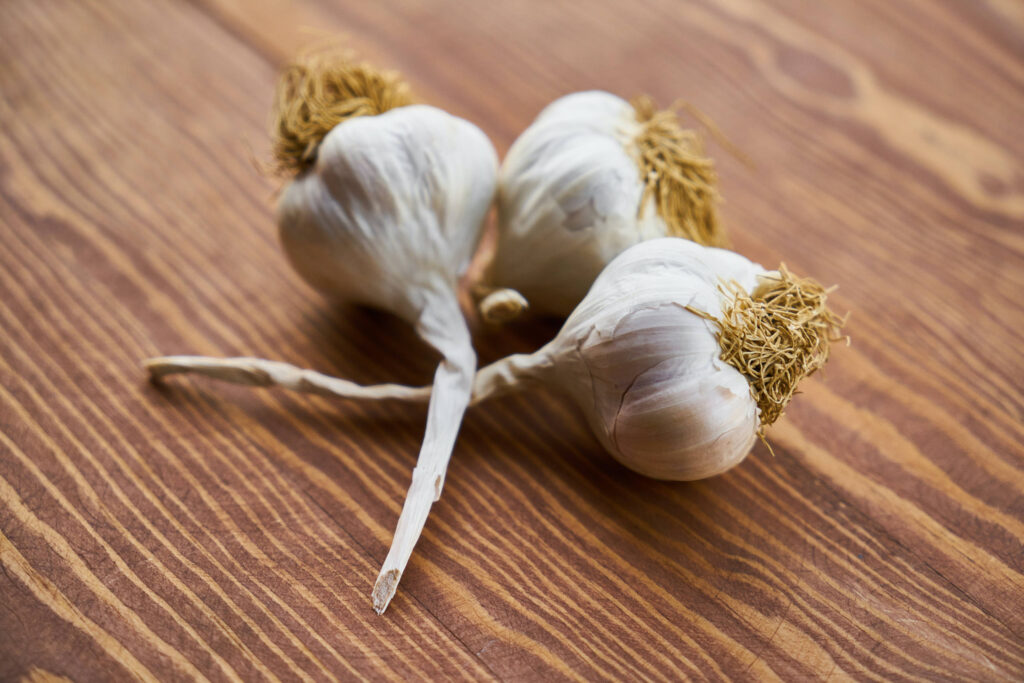
Actually, I have two favorite herbs – garlic from the west and turmeric from the east. Why? Because they are both so important to so many systems in the body. Obviously, we need to get to the t’s before we discuss turmeric, but in the meantime, let’s look at garlic.
In 2004, a study determined that genetically there were 211 different species of garlic, They are divided into two groups: soft necked and hard neck. There are also eleven horticultural groups of garlic, and three are classified as softneck garlic (Allium sativum), and eight grouped as hardneck garlic (Allium ophioscorodon).
The hard necked include the following groups: purple stripe, glazed purple stripe, marbled purple stripe, porcelain, Rocambole, Asiatic, and Creole. And the soft necked include three groups: artichoke, silverskin and Middle Eastern.
Note: elephant garlic is actually a leek, not a garlic.
Despite all the different types of garlic, they basically have the same nutrients. Over 350 nutrients. 33 of them are sulfuric compounds which are hugely important to the body in and of themselves.
So, what are the nutrients in garlic? Here is a short list from: https://www.urmc.rochester.edu/encyclopedia/content.aspx?contenttypeid=76&contentid=11215-4
| Protein (g) | 0.57 |
| Total lipid (fat) (g) | 0.04 |
| Carbohydrate, by difference (g) | 2.98 |
| Energy (kcal) | 13.41 |
| Sugars, total (g) | 0.09 |
| Fiber, total dietary (g) | 0.19 |
| Calcium, Ca (mg) | 16.29 |
| Iron, Fe (mg) | 0.15 |
| Magnesium, Mg (mg) | 2.25 |
| Phosphorus, P (mg) | 13.77 |
| Potassium, K (mg) | 36.09 |
| Sodium, Na (mg) | 1.53 |
| Zinc, Zn (mg) | 0.1 |
| Copper, Cu (mg) | 0.03 |
| Manganese, Mn (mg) | 0.15 |
| Selenium, Se (mcg) | 1.28 |
| Vitamin A, IU (IU) | 0 |
| Retinol (mcg) | 0 |
| Carotene, beta (mcg) | 0 |
| Carotene, alpha (mcg) | 0 |
| Vitamin E (alpha-tocopherol) (mg) | 0 |
| Cryptoxanthin, beta (mcg) | 0 |
| Lycopene (mcg) | 0 |
| Lutein + zeaxanthin (mcg) | 2.34 |
| Vitamin C, total ascorbic acid (mg) | 2.81 |
| Thiamin (mg) | 0.02 |
| Riboflavin (mg) | 0.01 |
| Niacin (mg) | 0.06 |
| Pantothenic acid (mg) | 0.05 |
| Vitamin B-6 (mg) | 0.11 |
| Folate, total (mcg) | 0.27 |
| Vitamin B-12 (mcg) | 0 |
| Vitamin K (phylloquinone) (mcg) | 0.13 |
| Folic acid (mcg) | 0 |
| Folate, DFE (mcg_DFE) | 0.27 |
| Cholesterol (mg) | 0 |
| Fatty acids, total saturated (g) | 0.01 |
| Fatty acids, total monounsaturated (g) | 0 |
| Fatty acids, total polyunsaturated (g) | 0.02 |
From https://www.ncbi.nlm.nih.gov/pmc/articles/PMC3731019/, we find that “Garlic contains about 10 different kinds of natural sugars which make up about a fourth of its substances; they include fructose, glucose, inulin and arabinose…”
“Garlic contains approximately 33 sulfur compounds (aliin, allicin, ajoene, allylpropyl disulfide, diallyl trisulfide, sallylcysteine, vinyldithiines, S-allylmercaptocystein, and others)
Several enzymes (allinase, peroxidases, myrosinase, and others)
17 amino acids (arginine and others)
Minerals (selenium, germanium, tellurium and other trace minerals)”
Components: (note: alliinase is an enzyme released when the clove is damaged or injured, ie., smashing it which is then converted to allicin)
Let’s look at some of the compounds and what they are known to do for us:
Ajoene: antimicrobial compound even kills E.coli, salmonella enteriitidis; prevents blood clots (derived through the conversion of allin into allicin)
Allicin (degrades & provides Hydrogen sulfides – known to prevent heart dysfunction/injury & provides thiols -> GSH; prevents oxidative stress; reduces angiotensin II thus reducing blood pressure; lowers blood sugar, lipids (LDL) & arthrosclerosis; helps muscles recover faster; protects against cancers (breast, colon, liver, head, neck, ovaries) too much can cause excess bleeding especially if taken with warfarin, aspirin, gingko!
Alliin, diallyl sulfide (anticarcinogenic; and improves iron metabolism), diallyl disulfide, diallyl trisulfide, ajoene, and S-allyl-cysteine
Anit-oxidants include: allyl cysteine, alliin, allicin, and allyl disulfide
Garlic doesn’t have nitric oxide but it activates nitric oxide synthase. This enzyme aids the conversion of nitric oxide from the amino acid L-arginine. Studies have shown that aged garlic extract can temporarily increase blood nitric oxide levels by up to 40% within an hour of consumption – wow. Nitric oxide provokes vasodilator – relaxes the arteries allowing better blood flow
Organic sulfides (hydrogen sulfide – known to inhibit blood clots, lower blood pressure, as well as both cardioprotective and cellular protective)
Saponins (several found only in purple garlic; otherwise typically 40x higher in red than white garlic), they are anti-bacterial, anti-fungal anti-inflammatory, antioxidant and inhibit cholesterol absorption without changing HDL levels
20 phenolic compounds or polyphenols: tannins, phenolic diterpenes, flavonoids (β-resorcylic acid, followed by pyrogallol, gallic acid, rutin, protocatechuic acid, as well as quercetin), and more stable with cooking processes; provide antioxidants, anti-inflammatories, antimicrobial, anti-diabetic, anti-cancer, etc;
Polysaccharides: mostly monosaccharides but effective antioxidant, anti-inflammatory and/or immunomodulatory
33 sulfur compounds (great for glutathione, connective tissue) – diallyl thiosulfonate (allicin), diallyl sulfide (DAS), diallyl disulfide (DADS), diallyl trisulfide (DATS), E/Z-ajoene, S-allyl-cysteine (SAC), and S-allyl-cysteine sulfoxide (alliin) (many of the sulfurs compounds have higher digestibility than the cooked ones)- the cysteine helps you produce glutathione, the thiols are important anti-oxidants. Sulfurs play a role in hair, muscles, teeth, and skin proteins/collagen.. Sulfur also contributes to fat digestion and absorption, because it is needed to make bile acids.
Probiotics: Lactobacillus and Bifidobacterium, (and contains sugars and amino acids used by the bacteria)
As far back as in Egyptian, Greek, Roman, Chinese, and Indian cultures, people have used garlic for medicinal purposes. So, what is garlic good for?
Actions:
- Antioxidant (stronger with raw garlic; and black garlic being the best) especially ferric ion reducing antioxidant power (ie., a type of free radical),
- Anti-inflammatory (the ethyl linoleate reduces production of NO, TNF, Interleukins – IL1 and prostaglandins)
- Antimicrobial: antibacterial, antifungal, (has a broad spectrum of both & in particular:
- Aspergillus, (12 types of mold that live in the gut; peanuts predominant cause)
- H. Pylori (lives in the GIT of 2/3 of the worlds population)
- Penicillum citrinum (fungus used to produce a statin compound),
- Pennicillum expansum (soil mold),
- Burkholderia cepacian (bacteria found in soil & water),
- Staphylococcus aureus (gram + Bacteria of the firmicutes family – upper respiratory & skin),
- E. Coli (bacteria in the gut)
- Bacillus subtilis (gram positive bacteria found in the soil and the gut)
- Anticancer
- Anti-diabetic
- Anti-obesity
- Cardiovascular protective
- Digestive system protective
- Hepatoprotective
- Neuroprotective
- Renal protective properties
- Vasodilator – promotes nitric oxide action
Ailments:
- Anti-microbial (bacterial, viral, fungal, yeast, worm)
- Cardioprotective
- Combats allergies – although some are allergic to garlic
- High blood pressure
- High cholesterol (lowers absorption of LDLs without impacting HDLs)
- Diabetes
- Immune system
- Improves iron metabolism
- Regulates blood clotting
- Respiratory issues
- Treats toothaches
- Treats skin infections (ringworm, athlete’s foot)
- Treats warts and corns
So how do we grow garlic? Garlic is so simple and it is beneficial to most things that grow in the garden. The only plants i have read that garlic doesn’t grow well with are: asparagus, peas, beans, sage, parsley and strawberries.
They like the cold – so planting in late winter/early spring or preferably the fall. However, if you live in a more tropical climate and don’t get the cold winters, you can still grow garlic. Put the whole bulb in the fridge for about 6 weeks; then split the cloves off and plant like you normally do. And voila you have garlic.
It doesn’t like a lot of rain, so decks and patios work great.
It does need a lot of sun – but partial shade will do.
A sandy loam is the best soil, with good drainage; compost/manure for nutrients.
Garlics, like onions, are a strong feeder, so adding some garden food before planting can help feed the plants into the spring. Adding plenty of leaf compost and/or aged manure to the soil will provide the garlic with the proper level of fertility.
Here’s to the benefits of garlic in your body and in your garden.
Dr Holly
